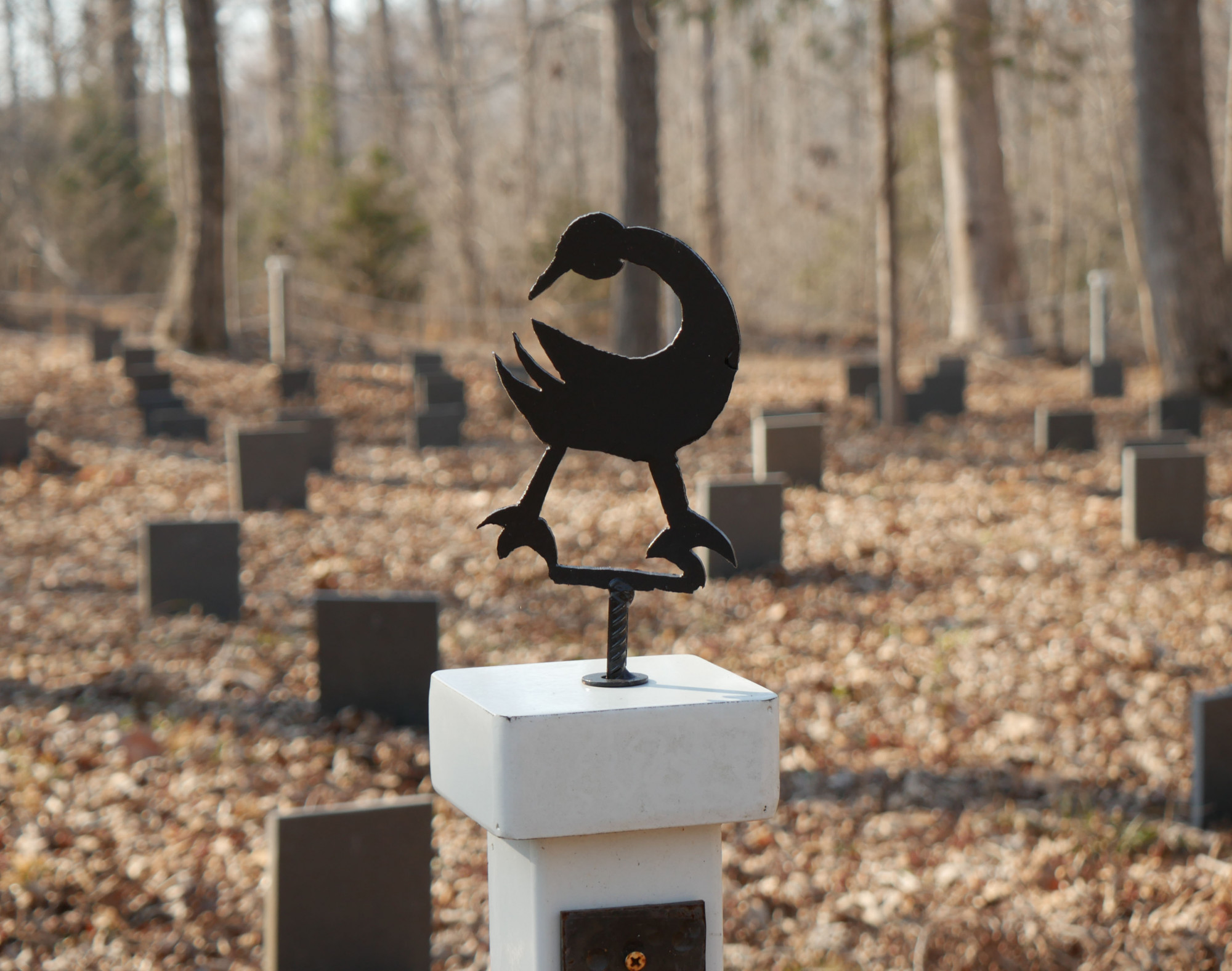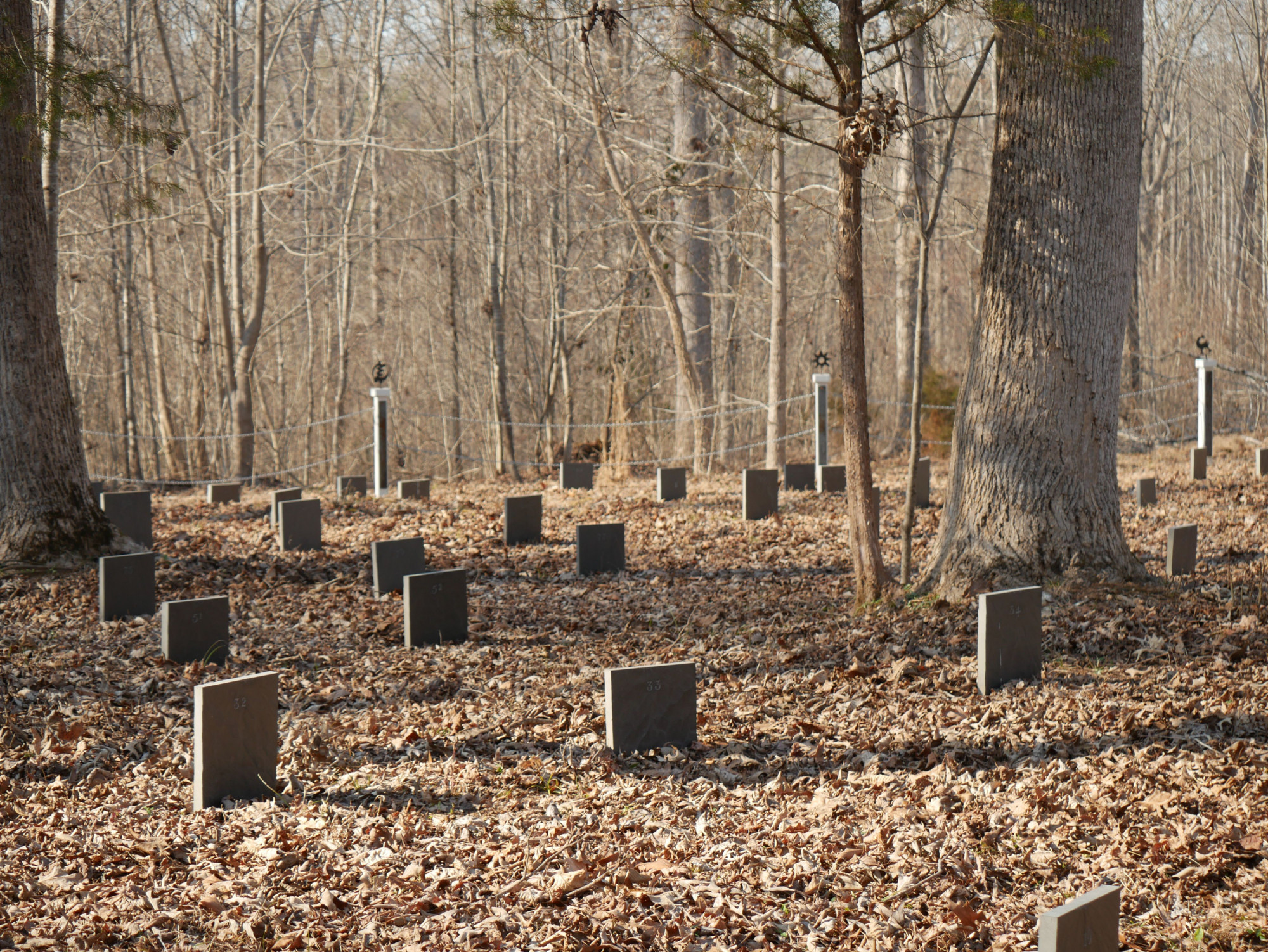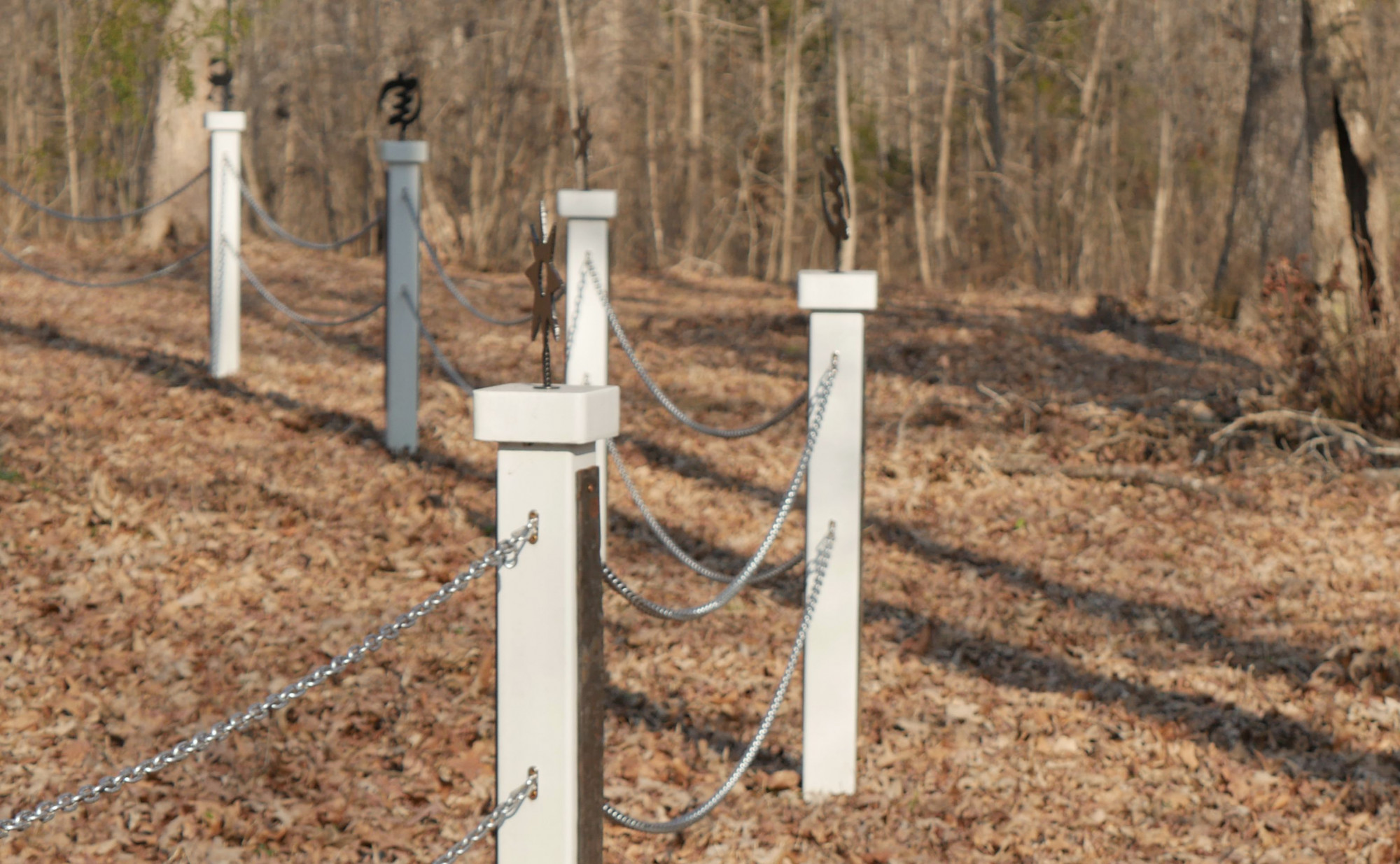The 144 of Rock Hill, SC
Preserving a once-forgotten cemetery of enslaved people
By Caroline McCoy
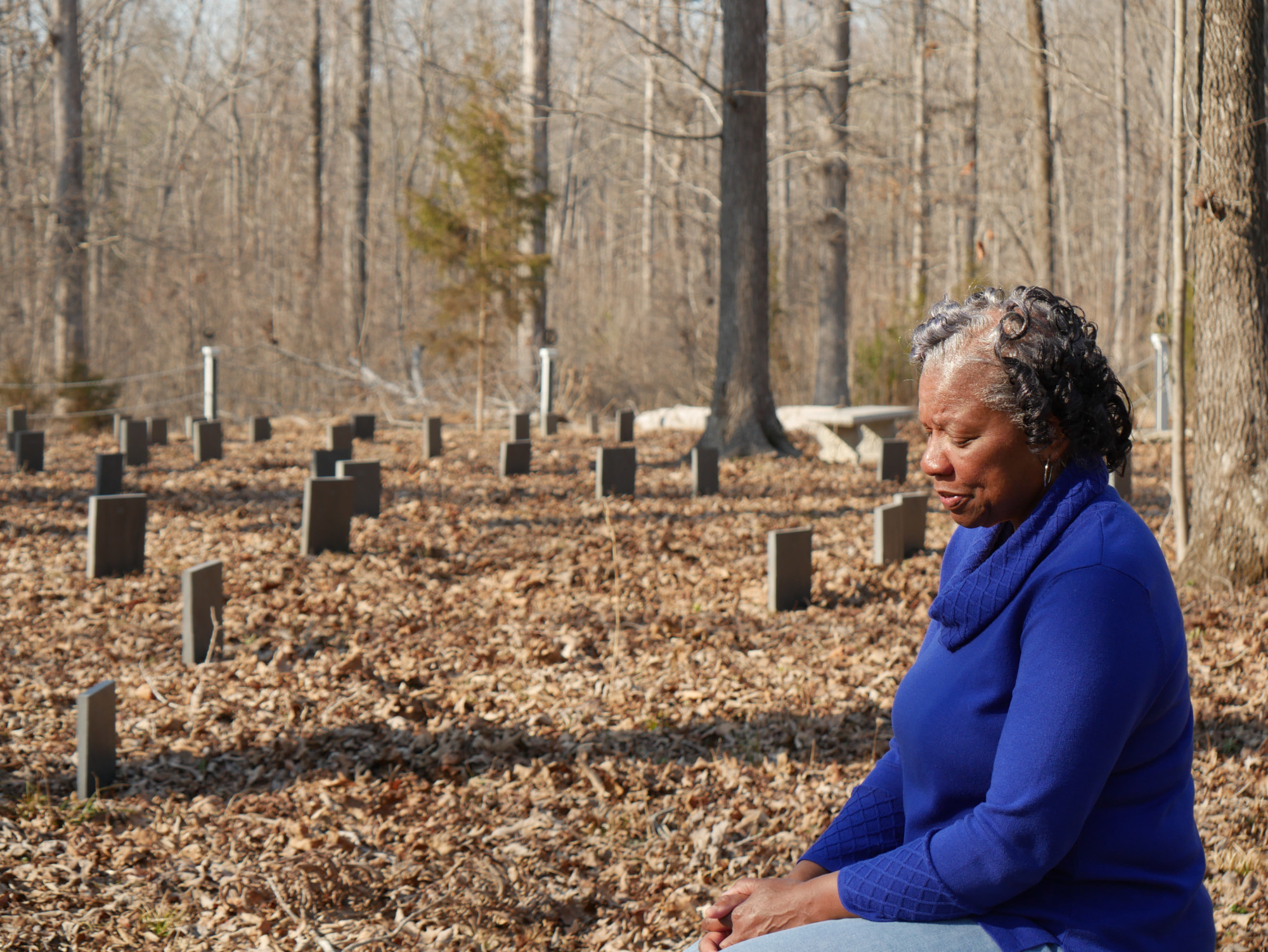
Sarah Lowry at Fishing Creek Place Cemetery; Photo by Sidney Donnan
First, they heard the rumor. In 2021, as Andrew Lazenby and his wife, Mary, toured the hundred-acre property for sale on the rural outskirts of Rock Hill, South Carolina, the owner who had been guiding them gestured toward a wooded area and said, “Oh, there’s an old slave cemetery over there.”
The couple was curious but skeptical. “Folks come up with stories, and stories get passed on, and they get retold, and things grow,” Lazenby said. Whether or not there was a cemetery on the land did not factor into their interest in purchasing it. At the time, they were on a nature-minded mission to preserve as much outdoor space as they could afford to preserve in their hometown. The Lazenbys are both artists with an affinity for outdoor recreation and nature conservation. Mary is a painter and bookmaker whose work often incorporates wildlife imagery. Andrew is a biologist and botanist turned glass worker who gained recognition for designing intricate marbles. Together, they own Blue Goose Art Supply near their alma mater, Winthrop University.
The Lazenbys were nearing their fifties in 2021 and eager to focus more of their attention on land conservation. Andrew was already serving on the board of the Katawba Valley Land Trust and was well-versed in the process of protecting private property from development through conservation easements. This property—part farmland and part forest extending northward to Fishing Creek, a tributary of the Catawba River—had caught the attention of a local developer, which spurred the Lazenbys to act quickly. They told the owner that they’d purchase the place, then asked her if they could go for a walk to see if they could find the old cemetery she’d mentioned. “She, of course, graciously said we could. And so my wife and I went tromping through the woods.”
They realized that there might be some truth to the property owner’s claim when they began stepping through periwinkle, a dense, creeping ground cover that indicated human disturbance. As a botanist, Lazenby knew that the non-native plant was “historically used to keep weed growth and grass growth in graveyards to a minimum.” Periwinkle sprawled over roughly twelve acres, which made identifying its origin point difficult. Eventually, though, the couple arrived at several roughly hewn stones, each marked by a letter or two carved into its face. That they were standing in a burial ground seemed obvious, but the Lazenbys—soon-to-be owners of this burial ground—decided that they needed to know the story behind it.
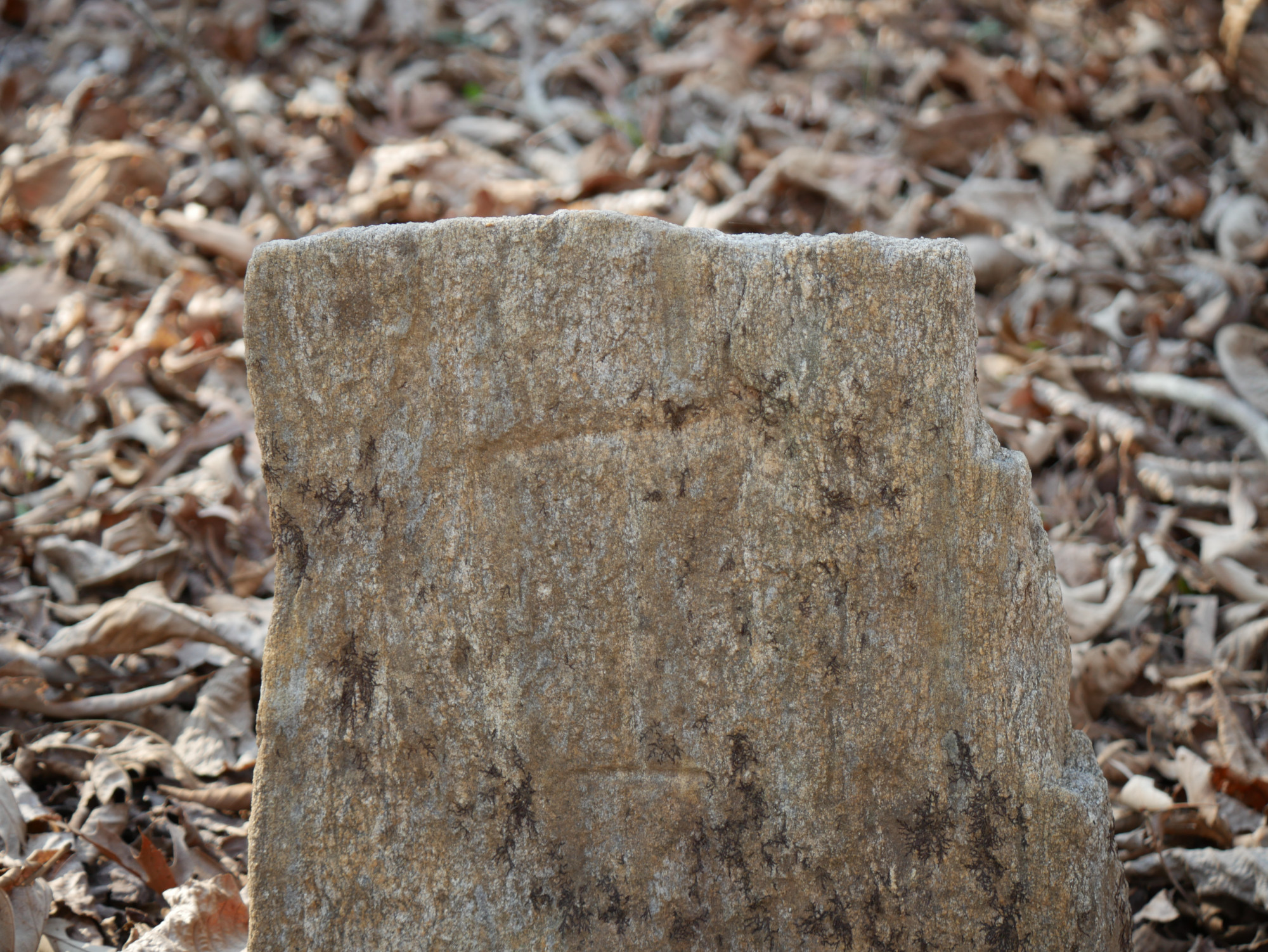
Photo by Sidney Donnan
Early into their ownership of the property, Andrew Lazenby called York County to report the graveyard and ask whether or not it matched any historical records on file. “They came out and kind of looked at it and said, ‘Yep, you got a cemetery,’” he said. As far as the county was concerned, that was that. The Lazenbys were disappointed that no local officials seemed interested in helping them find documentation related to the property. They began clearing the area around the stones, removing underbrush and small trees to try to determine the scale of the cemetery, which they thought might lead them to answers. “And so we kept clearing and kept clearing and it kept getting bigger and bigger,” Lazenby said. “We found more and more depressions that were about grave size.” Those depressions were oriented east to west in neat rows, following Christian burial tradition.
Lazenby’s scientific background made him wary of confirmation bias. The rumor—that the cemetery held enslaved people—was not particularly far-fetched in Rock Hill and greater York County, South Carolina, where much of the antebellum economy relied on cotton. By the start of the Civil War, enslaved people accounted for nearly half of the county’s population. And yet, the Lazenbys wanted to rule out myriad other possibilities that could explain the cemetery—Revolutionary and Civil war battles, pandemics, early settler villages, and long-gone churches. “We tried to make it be everything we could but a slave cemetery,” Lazenby said, “simply because it’s really easy to research yourself in a direction that you want to go.” Each time they exhausted an alternative option, they became more certain of the original story.
To aid them in their research, the Lazenbys hired local historian Joel Hohmann, who traced property records, beginning with an eighteenth-century King’s Grant, to the Lowry family, who had moved to South Carolina from Pennsylvania in the early nineteenth century and held the land until around 1950. The Lowrys were cotton farmers and enslavers. Hohmann analyzed census records and newspaper clippings, as well as papers and artifacts supplied by descendants of the family. He was able to confirm that at least eleven cabins had once housed enslaved people on the property, though no trace of these structures remains. “Slave owners didn’t necessarily keep record of how many slaves they bought,” Hohmann said, though census takers during the nineteenth century recorded increases in the number of people the family reported as property with each decade that passed. At the time of emancipation, the Lowrys were forced to release 155 people that they had enslaved, according to these records.
Hohmann also realized early on that the Lowrys had traded, loaned, and gifted people among three other prominent local families: the Averys, the Williams, and the Brattons, who are well known in York County as the owners of Brattonsville, a pre-Revolutionary War cotton plantation that was listed on the National Register of Historic Places in 1971. Now a museum, the place earned notoriety as a filming locale for the 2000 movie The Patriot, starring Mel Gibson. “Mr. Bratton was a horrible human,” Lazenby said. “They sort of don’t tell you that on the tours, but, I mean, he founded the Klan in York County.”
As Hohmann continued his research, the Lazenbys were pondering the idea of restoring the cemetery and making it accessible to the public. Based on the history they’d confirmed, they were nearly certain that the cemetery held people who had been enslaved on their land. They had established a conservation easement for the majority of their property, leaving just fifteen acres available for the construction of their own home. This meant that the cemetery would be protected in perpetuity from development. But the Lazenbys believed that their community needed more than an unmarked patch of ground. Both Andrew and Mary grew up in Rock Hill. They met in the ninth grade and married while Andrew was in the Air Force. After four years of service, he left the military, and the couple settled back in their hometown. “We’ve got deep roots here,” Lazenby said. Those roots extend through generations of family members and come with a knowledge of the region’s racist history. “I was in school in the early 80s. So the whole issue of slavery was just sort of hand-waved past,” he said. “There’s a lot of misconceptions in the public about, you know, what life was like.”
There was also, among some in the community, a sense that the past should remain in the past. One morning, Andrew Lazenby stopped into his local gas station for breakfast. Though he and Mary had been secretive about their efforts to determine the history of the cemetery, for fear of spreading incorrect information, a few neighbors had caught wind of the project. One was in the gas station that morning and offered Lazenby some advice. “I was told . . . ‘You need to plow those things under and not tell anybody,’” Lazenby said. Instead, he began consulting with African American leaders in the area, seeking their input and sharing his and Mary’s plans to restore the cemetery. “They more or less gave us their blessing.”
Lazenby called Bryan Davis of Charleston Underground Archeological Services, a small firm with a word-of-mouth client base. Though he now operates out of Virginia, Davis began his career in Charleston, South Carolina, working with historic organizations and museums as well as home remodelers who needed archeological surveys. Along the way, private land owners began contacting him to assess their properties, which he does with a variety of tools, including ground-penetrating radar. Davis said that he is discerning when it comes to accepting jobs and often refers people elsewhere if the scope of a request is too large for his team to accommodate. The Lazenbys were unsure of the size of the cemetery on their land, so they chose one hundred square feet around the existing stone markers for Davis to analyze. (They later expanded that area, recognizing that the cemetery extended beyond it.)
Using ground-penetrating radar and a stiff criteria—“We had to have either two walls or three corners to call it a grave”—Davis began mapping the cemetery. At Lazenby’s urging, he also called Dr. Edward West, an osteoarchaeologist who specializes in DNA matching between the living and the dead. Their hope was that they could offer descendants a biological link to their ancestors. Unfortunately, the soil profile—Iredell red clay—is not a great preserver of DNA. “It’s extremely acidic,” Davis said. “It’s . . . virtually impossible to have any remains left.”
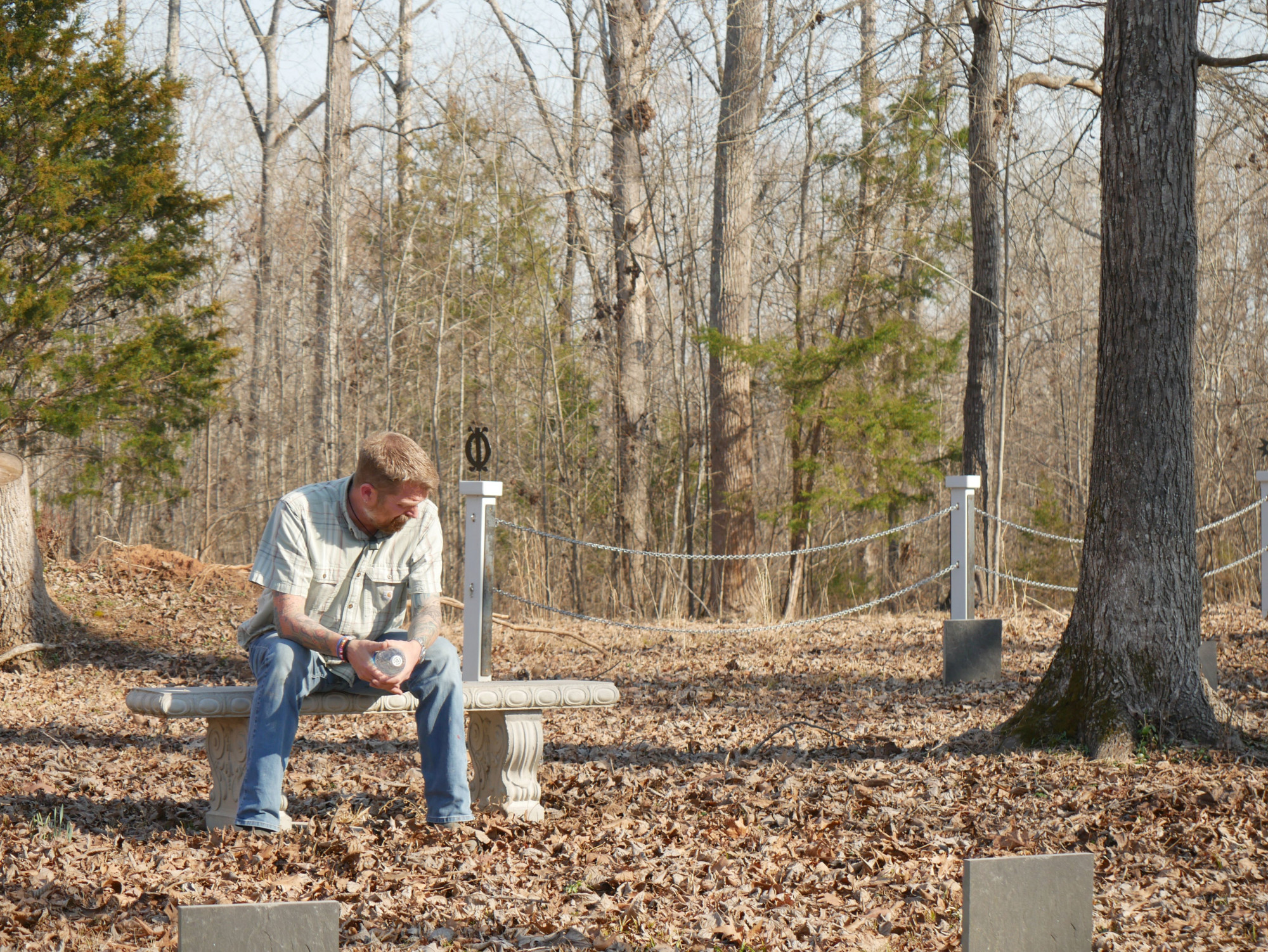
Andrew Lazenby at Fishing Creek Place Cemetery; Photo by Sidney Donnan
DNA might have expedited the process of locating descendants, but Lazenby and historian Joel Hohmann had also begun tracing ancestral lines through archival records. “We wanted to try to tie [the cemetery] to a family, or families, that were still in the local area,” Lazenby said. This line of research was also difficult. He reached out to friends and trusted community members who could spread the word of the project with both discretion and sensitivity. Often, he heard that the keeper of pertinent information had died. “We realized we were losing this history at an alarming rate, just simply because it wasn’t written down. It was all oral tradition.”
When they followed a family tree to a man named Guy F. Lowry, Hohmann and Lazenby thought they had reached another dead end. “The trail just went cold,” Lazenby said. Then he met Sarah Lowry, a Rock Hill native who, at age sixty-seven, still lives on the land her great-grandfather purchased and farmed. Lowry knew she was descended from the enslaved at Brattonsville. She had been volunteering with the museum, telling visitors about her heritage and showing them portraits of her father, George Henry Lowry, Sr., her grandfather, John Lowry, and her great-grandfather, Johnny Lowry. Sometimes, she would display her family Bible, which is undated. “It’s so ratty I can’t carry it anymore because it’s falling apart,” Lowry said.
She doubted that her relatives could be counted among those buried on the Lazenbys’ property. For one thing, there was some variation in the spelling of the last name Lowry in the records Hohmann and Lazenby presented to her. Mostly, though, the story she knew, which was limited in detail, had only ever included Brattonsville. But when she confirmed that Guy F. Lowry was her uncle, her father’s brother, Sarah Lowry solidified her link to those enslaved and buried on the Lazenbys’ land. “It came as a surprise, because I did not know,” Lowry said. “My family did not talk about . . . slavery. . . . So I have to rely on documents people give to me right now. . . . And I think that was my loss, right there. No one spoke about it. I did not know to ask about it.”
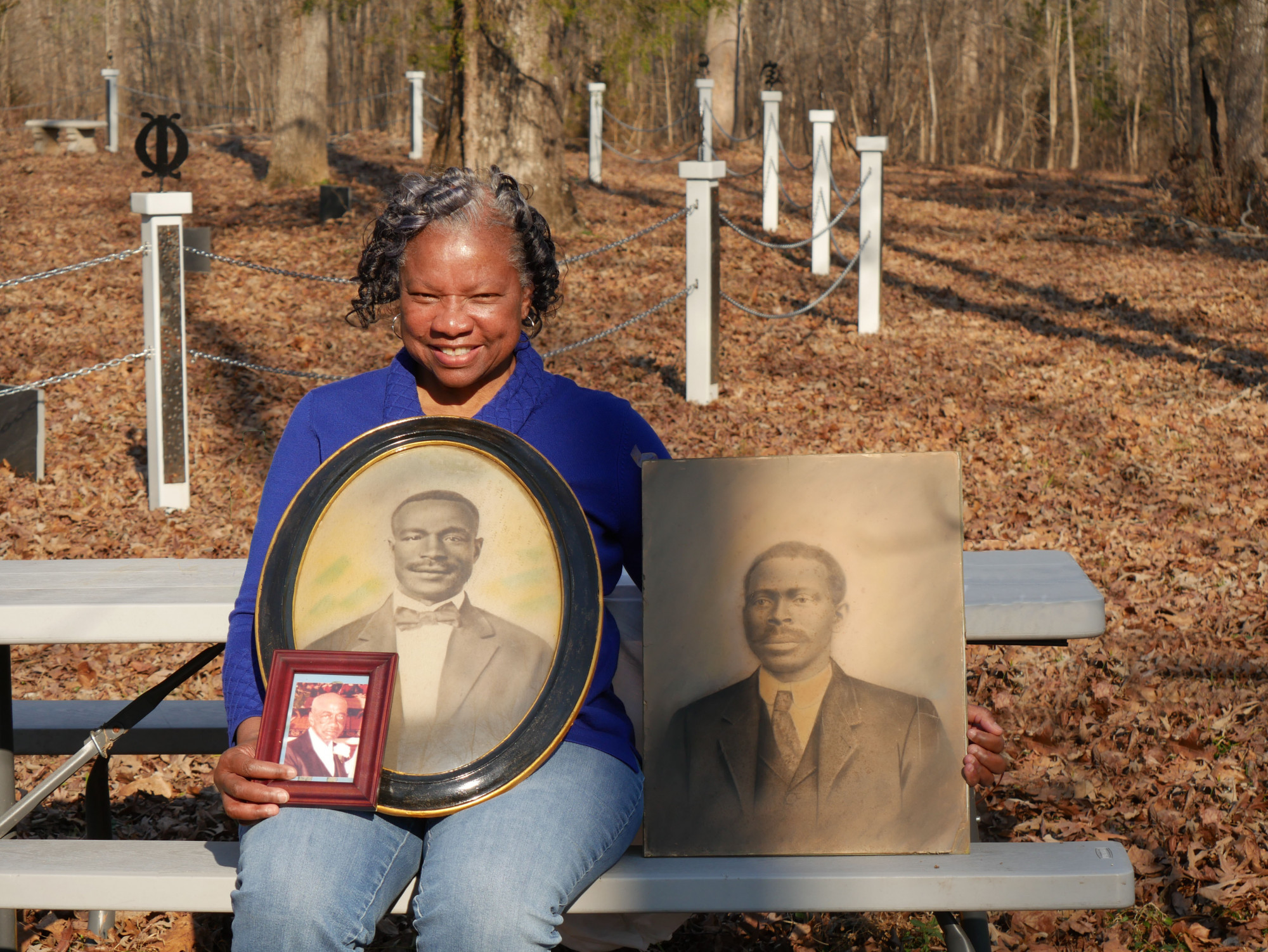
Sarah Lowry with portraits of her father, grandfather, and great-grandfather; Photo by Sidney Donnan
When Davis finished mapping the cemetery, he had confirmed 144 graves. Both he and Lazenby said that there are likely more. “We never wanted to be in a position where folks would remove numbers that we found,” Lazenby said. “We can always add them later, as technology improves or we find more information.” He and Davis said that anomalies in the ground indicated burial sites that they couldn’t map with absolute certainty. And in the minds of the Lazenbys, the descendants of those enslaved and buried on their land deserve as much certainty as possible.
During the mapping process, Davis had marked each unmarked grave with a rebar stake tagged with a number. Though the few original stones that remain are engraved with letters, some of which align with the names of enslaved men referenced in Lowry family papers—Jesse, Horace, Henry—the Lazenbys are wary of making any assumptions about who might be buried where. “Finding names for these graves is impossible,” Lazenby said. “Typically, burials were, you know, done at night, after the work day, typically in the dark. It’ll be three or four men and an overseer simply because they weren’t allowed to congregate. And, you know, it just wasn’t recorded . . . that’s disappointing in a lot of ways, but we still felt like they all needed to be remembered.”
Lazenby called an artist friend, an iron worker based near Charlotte, North Carolina, to commission a fence that would surround the cemetery. Not wanting to impose a particular religion on everyone buried there, the Lazenbys chose to accent the fence with secular Adinkra symbols of Ghana. They also hired a slate worker to make 144 numbered headstones, which they ordered by Davis’s map. They hoped that marking each unmarked grave would restore the dignity that had been denied those who were enslaved on their land. “A section of woods that’s been cleared, that’s full of headstones—it helps tell the story of these people,” Lazenby said.
After they had mapped the cemetery and advanced their research, the Lazenbys continued to contact various institutions with news of the project. They were eager to share information and optimistic that others would be interested in reviewing their findings. “We reached out to all the major schools in North and South Carolina that have any form of department that would cover this,” Lazenby said. The responses they received were tepid. Some organizations assumed that the Lazenbys were seeking funding, though they had decided early on that they would not accept monetary donations for any work they commissioned for the cemetery. “One, we’re not a nonprofit, and it would get really confusing,” Lazenby said. “And two, we did not ever want it to look like we were profiting off this.” To ensure transparency, the couple has put the acreage they have under conservation easement—including the cemetery—into a land trust that benefits natural spaces throughout York County. (Anyone who wants to aid in the cemetery’s preservation must donate to the benefit of the land trust overall.)
In their effort to preserve the cemetery on their land, the Lazenbys had arrived at an understanding of the great number of burial grounds that were likely lost or forgotten, plowed under and not discussed by white landowners. They were discouraged by the lack of interest they received from regional institutions. “It sort of demonstrated the uphill climb that folks are having to reclaim their history,” Lazenby said. Nationally, though, there are several initiatives aimed at identifying and preserving African American burial grounds, including the Black Cemetery Network, where the Lazenbys listed their site under its official name, Fishing Creek Place Cemetery. Since the 2022 passage of a public land bill aimed at preserving Black cemeteries, the National Park Service has overseen the African American Burial Grounds Preservation Program.
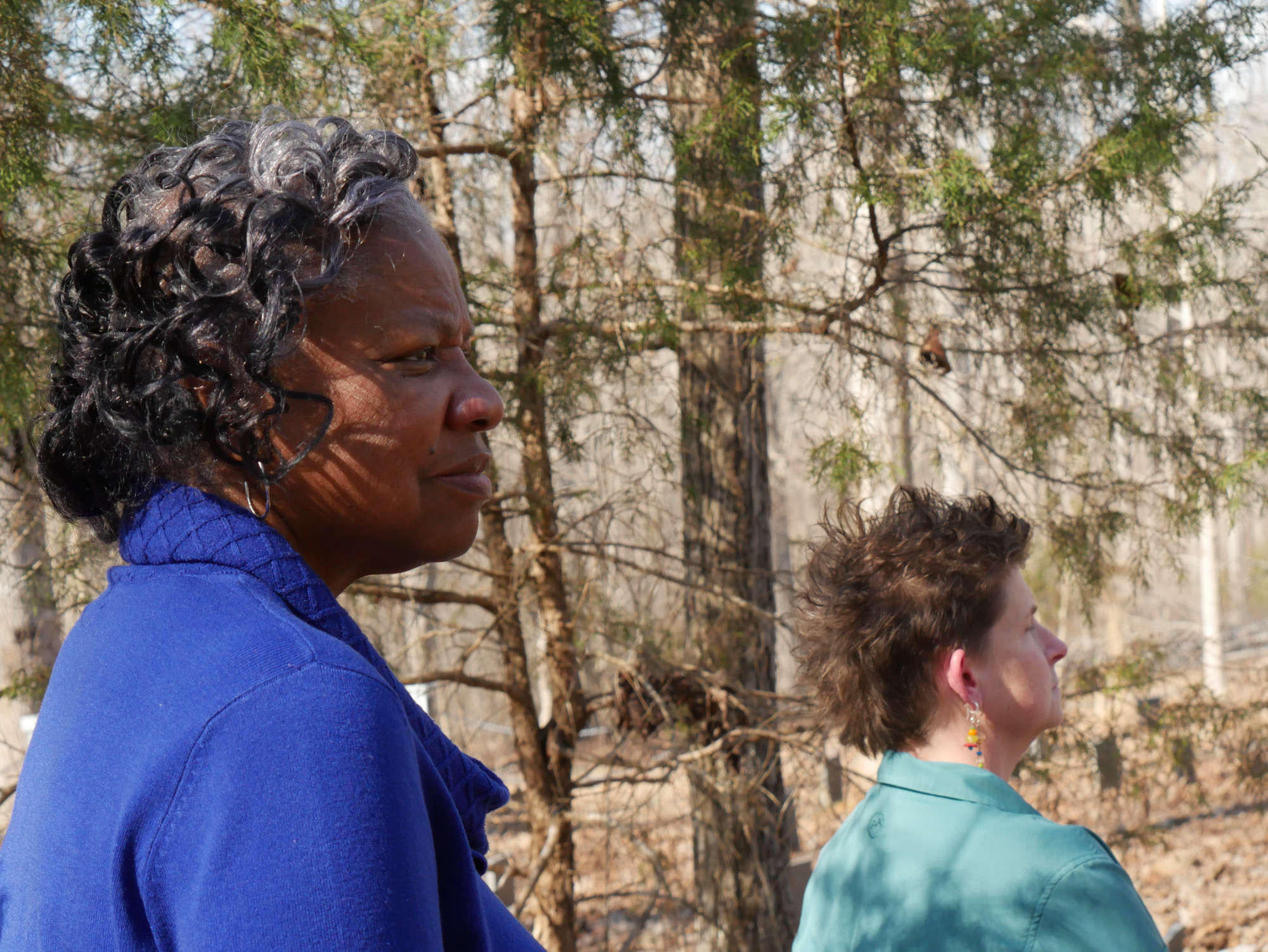
Sarah Lowry and Mary Lazenby at Fishing Creek Place Cemetery; Photo by Sidney Donnan
If the cemetery didn’t seem to matter to big museums or universities, it did to the community of Rock Hill and the descendants of the enslaved. In February of 2023, less than two years after the Lazenbys first heard the rumor that would set them on their mission, 144 guests arrived on their property for the opening of Fishing Creek Place Cemetery. The name was chosen “to honor those who are interred here while not celebrating the name of the plantation that they were forced to work on,” Lazenby said. Sarah Lowry and several other Lowry descendants attended the event, which was hosted by the Nation Ford Land Trust. Since then, groups have visited from all over York County and beyond. Some in town say that the Lazenbys’ work inspired nearby Brattonsville to mark a cemetery on the museum site, a project that was completed and unveiled in late March of this year. (Olivia Mitchell, the media contact for the museum, said that the initiative to preserve the cemetery at Brattonsville has been ongoing for years.)
People tend to hear about Fishing Creek Place Cemetery through word of mouth or the county tourism website. The Lazenbys also post information for visitors on their Blue Goose Studios website. Recently, Andrew welcomed a women’s garden club to the cemetery. His tours are personalized, meaning that he shares as much information as people seem to want. During this particular tour, he referred to the Lowry plantation as a forced labor camp. “One of the ladies leaned over, and she put her hand on my arm and said, ‘Well, honey, I thought you said this was a plantation.’” Lazenby reiterated his choice of terminology. “Seeing people learn—it’s been interesting,” he said.
For some, Fishing Creek Place Cemetery is an educational experience, but for others in York County, it’s a family memorial. Sarah Lowry has returned to the cemetery several times, both because she and the Lazenbys have become friends and because she likes to sit in community with her ancestors. “When I go there,” she said, “it’s a sense of belonging.”
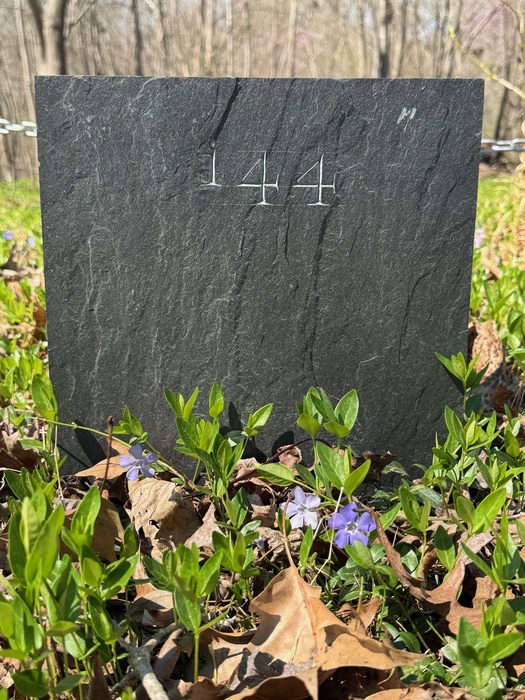
J. David Gillespie carved each slate headstone by hand; Photo by Andrew Lazenby





